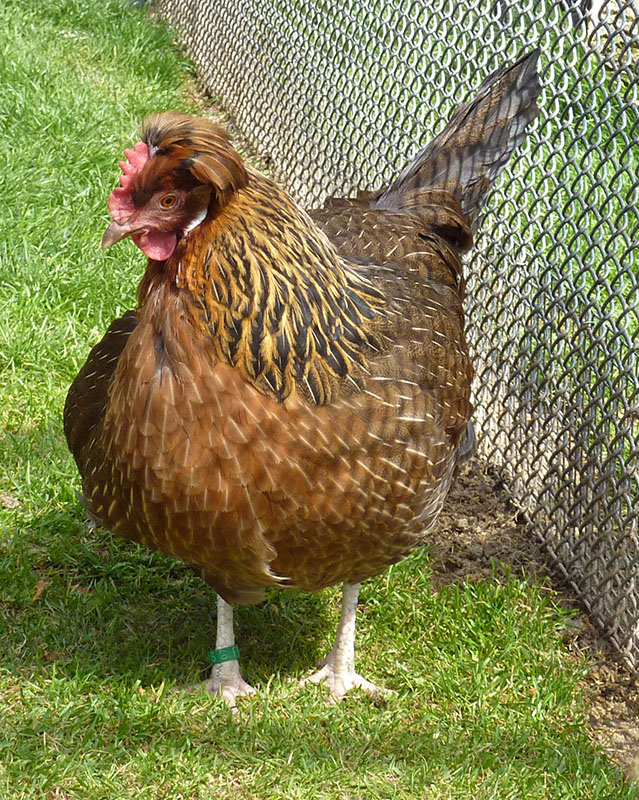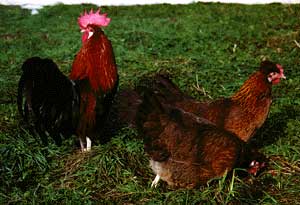Styrian Chickens
Th e Styrian hen – Stajerka in Slovene, Altsteirer Huhn in German – is the native breed
of hen in Slovene and Austrian Styria. It originates in the region between the rivers
Mura and Sava in the Slovene part of Styria and in the southern part of Austrian Styria.
In the past, four varieties of color appeared: light brown, white, barred and partridge-colored.
The last one is the most spread and preserved.
e Styrian hen – Stajerka in Slovene, Altsteirer Huhn in German – is the native breed
of hen in Slovene and Austrian Styria. It originates in the region between the rivers
Mura and Sava in the Slovene part of Styria and in the southern part of Austrian Styria.
In the past, four varieties of color appeared: light brown, white, barred and partridge-colored.
The last one is the most spread and preserved.
Description
Hens of this breed mature early, are lively, solid and are quite good layers. Their meat is of good quality, the skin is white and eggs are of medium size. The chest length, width and depth ratio is 8:5:3. The chest line is well rounded while the crammed belly stresses its strong figure. Feathers on the neck and on the tail are rich; the comb is straight. The back slightly inclines towards the end of the body and it seems wide if looked from the upside down.
Description of the Cock
 A fully grown cock weighs between 2.5 and 3.0 kg. It has a small, fine-shaped head
and a short, strong beak of white or meat-like color (rimmed with horn-color). The
red eyes give an impression of ardor. The comb is of medium size, simple, straight
and rises from the front to the back. It is precisely toothed. Behind the comb there
is a tassel of thin tufts of feathers, sometimes it consists of only a few longer
feathers. The earlobes are white and very small. The wattles are short to medium size
and intensively red. The face should be red; if it is white it is considered a deficiency.
The neck is of medium length, straight, with rich feathers of brown-red color that
become black on the chest. The chest is well rounded, wide, a bit embossed and deep.
The body seems stocky due to the crammed belly and back. The back slightly inclines
towards the tail, and it is long and wide. The cock's shoulders, back and saddle are
dark red; while the wings, that are close on the body, are black with brown external
rim. The tail is crammed and wide, upside turned, with nicely curved main and side
feathers in the form of a sickle. The tail is high, not steep and it emerges from
the body at a blunt angle. Main and side feathers of the tail are wide and round off
at the end. They are black and splendor, with a metallic shine. Legs are narrow (thin),
of medium size with thin bones, without feathers. Thighs are hardly seen. Legs are
white, with some red places between toes. There are also red spots on the sides of
the legs.
A fully grown cock weighs between 2.5 and 3.0 kg. It has a small, fine-shaped head
and a short, strong beak of white or meat-like color (rimmed with horn-color). The
red eyes give an impression of ardor. The comb is of medium size, simple, straight
and rises from the front to the back. It is precisely toothed. Behind the comb there
is a tassel of thin tufts of feathers, sometimes it consists of only a few longer
feathers. The earlobes are white and very small. The wattles are short to medium size
and intensively red. The face should be red; if it is white it is considered a deficiency.
The neck is of medium length, straight, with rich feathers of brown-red color that
become black on the chest. The chest is well rounded, wide, a bit embossed and deep.
The body seems stocky due to the crammed belly and back. The back slightly inclines
towards the tail, and it is long and wide. The cock's shoulders, back and saddle are
dark red; while the wings, that are close on the body, are black with brown external
rim. The tail is crammed and wide, upside turned, with nicely curved main and side
feathers in the form of a sickle. The tail is high, not steep and it emerges from
the body at a blunt angle. Main and side feathers of the tail are wide and round off
at the end. They are black and splendor, with a metallic shine. Legs are narrow (thin),
of medium size with thin bones, without feathers. Thighs are hardly seen. Legs are
white, with some red places between toes. There are also red spots on the sides of
the legs.
Description of the Hen
A grown-up hen weighs between 2.0 and 2.5 kg. In the first year it lays about 245 eggs of ivory color. The average weight of hatching eggs is 55 g. The hen has a small head with small white earlobes and well rounded, rich tassel which should not cover the eyes. The comb is upright, simple, not too large and it is wrinkled in front. It is a specific trait. The back is quite horizontal, the frame of the body is heavily built, the chest is deep and the belly is very much expressed. Legs are of medium length, white and covered with slightly brown scales. The tail is wide and vertically directed, it is opened and emerges from the body at a blunt angle. The hen is partridge-colored. A thin black pattern on the brown back and covering feathers can be noticed. Feathers do not shine. The chest is of salmon color, the belly is light while the buttocks is gray.
Origin and Development
The Styrian hen is a native breed, although it may not originate from there. Its characteristics suggest common ancestry with other Mediterranean breeds.
The Styrian hen was first mentioned in the 13th century. The breeders became interested in the second half of the 19th century when they started to breed it systematically. However, it could hardly compete with modern laying, meat, and dual purpose breeds. It survived mainly due to enthusiasts who were breeding it for domestic use. The hen was first described in 1894 by the first association of breeders in Graz. The special characteristics of the Slovene part of the development of the native Styrian hen were capons that represented an ethnographic background. Capons were castrated and fattened cocks of this breed and have been considered as a culinary specialty for centuries.
In 1897, a breeding center for the Styrian hen was founded in Celje by the Association for Care and Rearing, but it was later moved to Maribor. In 1898 Emanuel Martiny began to stimulate the selection of the Styrian hen in Graz. Armin Arbeiter, who organized the breeding in Celje, called it the "Celje Hen." In 1900 the Association for Care and Rearing of Animals was founded in Celje in order to preserve and improve the breed by selection.
In 1902 names "the Celje Hen" and "the Old Styrian Hen" were omitted and since then it has been called the Styrian Hen. The Styrian Agricultural Company organized the first symposium in which the merits of the Styrian hen were stressed. The basic description of the breed was formed.
The importance of the Styrian hen was especially stressed on the poultry congresses in 1907 in Vienna, in 1908 in Graz and in 1913 in Maribor. The promotion of the Styrian hen somehow died away during the first world war. After the war, the breeding area of the Styrian hen was divided by the border. The residues of the Styrian hen were collected after the war and between the years 1920 and 1925 the association from Maribor organized an exhibition of the Styrian poultry. In 1932 there was an exhibition in Maribor, and in 1934 in Celje. In November 1930 a symposium (survey) took place in Celje in which the breed standard was defined. The second world war stopped the work on the Styrian breed. Only small numbers of animals were preserved. Between the years 1948 and 1959 the Selection Station at Loce near Poljcane re-introduced the breed but it was not economically viable. In 1970 it was continued by the Faculty of Agronomy in Ljubljana. Systematic work on the breed began in 1987. Since 1993, the Ministry of Agriculture Forestry and Nutrition has been supporting re-introduction of the breed.
References
Dr. Antonija Holcman, University of Ljubljana, Biotechnical Faculty, Zootechnical Department, 1230 Domzale, Slovenia. E-mail: antonija.holcman@bfro.uni-lj.si
